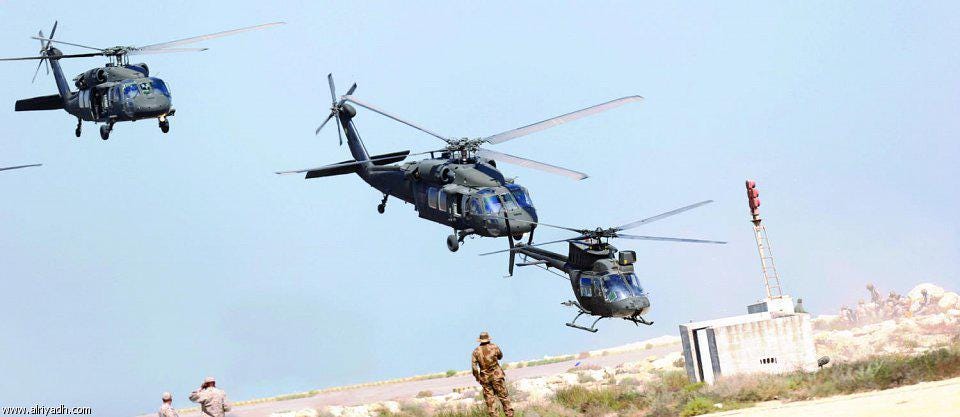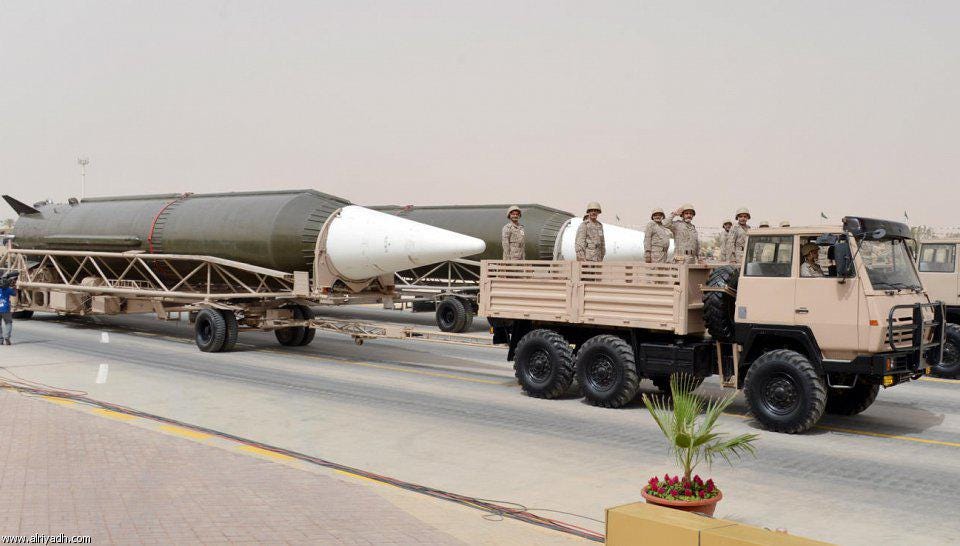Massive military exercise directed at troublesome neighbors
Jassem Al Salami in War is Boring
The Royal Saudi Arabian Armed Forces concluded the biggest military drill in their history on April 29. The “Sword of Abdullah” war game involved a staggering 130,000 soldiers, sailors, marines, airmen and missileers in three regions.
That’s more than half of the kingdom’s total military personnel. If the United States were to conduct an equivalent exercise, it would include more than a million people.
Make no mistake—the giant war game was a message for Iran. Although notonly Iran.
 The northern theater simulated a skirmish with Iraq. The southern sector played out battles with Shi’a militants from Yemen. It was in the east that Saudi forces conducted the kinds of maneuvers they might use in a war with Iran.
The northern theater simulated a skirmish with Iraq. The southern sector played out battles with Shi’a militants from Yemen. It was in the east that Saudi forces conducted the kinds of maneuvers they might use in a war with Iran.
That part of the exercise included massive amphibious assaults. Blackhawk helicopters inserted Royal Saudi Special Forces while AH-64 and OH-58 gunships and scouts flew top cover.
In the next stage, commandeered civilian landing craft delivered amphibious armored vehicles and marine units to link up with the Special Operations Forces.
Blackhawk and OH-58 helicopters during the war game. Al Riyadh photo
The air and sea assault training had a clear purpose. Iran uses three strategic islands in the Strait of Hormuz as bases for artillery, cruise missiles and fast boats—in order to be able block the strategic strait, in the event of open conflict.
In wartime, Arab Gulf states would need to seize these islands. Or blast them into chunks.
During the parade marking the war game’s completion, the Royal Saudi Strategic Forces displayed, for the first time, their DF-3 medium-range ballistic missile. Saudi Arabia reportedly acquired the missiles and their conventional warheads from China in 1987.
The DF-3 boasts a maximum range of 3,350 kilometers and can target Tehran from underground missile silos in central Saudi Arabia. Riyadh’s strategic forces are believe to have begun replacing the DF-3s with more advanced DF-11s or DF-15s starting in 2003.
In showing off the missiles, Saudi Arabia was essentially reminding Iran that it can strike the island bases as well as targets deep inside Iranian borders … without the help of the United States or another ally.
 DF-3 on parade. Al Riyadh photo
DF-3 on parade. Al Riyadh photo
The war game and its provocative parade are the latest signs of increasing tensions between Tehran and Riyadh. During negotiations over Iran’s alleged nuclear program, in 2013 the Saudi ambassador to United States published an op-ed in The New York Times vowing that the Saudis would confront Iran even without U.S. support.
The kingdom opened its wallet to back up its boast. The Royal Saudi Air Force signed a deal with the U.S. to buy more than 2,600 AGM-158 and AGM-84K cruise missiles and GBU-39 small diameter bombs.
And in early 2014, Saudi king Abdullah ordered a major reform of the country’s military and intelligence leadership, appointing a new minister of defense and replacing the notorious head of intelligence Prince Bandar Bin Sultan with the younger Gen. Youssef Al Idrisi.
Saudi Arabia has a robust military by regional standards—and a particularly capable air force. The kingdom’s F-15 and Typhoon fighters can launch cruise missiles from well outside Iran’s defensive umbrella.
 A Saudi air force tanker leads F-15 and Typhoon fighters. Al Riyadh photo
A Saudi air force tanker leads F-15 and Typhoon fighters. Al Riyadh photo
But Iranian air defenses are, in theory, capable of destroying incoming cruise missiles once they enter radar and rocket range. Tehran has developed long-wave early warning radars and guided anti-aircraft artillery and surface-to-air missiles specifically to counter Western cruise missiles.
And unlike the United States, Saudi Arabia does not have the weaponry and skills for suppressing an air-defense network. Riyadh has not invested in the stealthy drones and high-altitude spy planes it would need to detect radar and missile sites—nor the jamming planes to interfere with the radars.
Against Iranian counter-attacks, Saudi Arabia relies on obsolete French Crotale and U.S. Hawk anti-air missiles plus a smaller numbers of modern Patriot batteries. In the balance, Saudi Arabia’s military posture is more offensive than defensive.
Only the Patriots have any chance of intercepting Iran’s ballistic missiles. But Riyadh’s Patriots are older models. They are not linked to satellites, sea-based radars or long-range land radars. Lacking situational awareness, Saudi defenses would be fairly easy to spoof with decoys.
Riyadh is surely aware of its defensive limitations. A single refinery, the Abqaiq facility, processes 70 percent of the country’s crude oil. An explosion a few kilometers away from the complex in 2006 raised oil prices by two dollars per barrel.
The complex is fewer than 300 kilometers from Iran, well within range of Iranian ballistic and cruise missiles. A single Patriot battery defends Abqaiq. Saudi Arabia’s massive Ghawar oil field, lying 100 kilometers from Iran, is equally vulnerable.
With its military investments and huge war game, Riyadh aims to keep Iran in check—this despite Saudi Arabia’s defensive weaknesses. The question is whether Iran responds by cooling its own rhetoric … or pushing back.
No comments:
Post a Comment